
Daily Sumō Shows a New Attraction for Visitors to Osaka
Guideto Japan
Travel Sports- English
- 日本語
- 简体字
- 繁體字
- Français
- Español
- العربية
- Русский
A Great Introduction to Sumō
The recently opened Sumō Hall Hirakuza Osaka, located in the Nanba Parks commercial complex in Nanba, Osaka, offers visitors to Japan a chance to watch and learn about sumō year-round. Tourists from many countries have already reserved tickets for the attraction, which hopes to record 50,000 visitors over the next 10 months ahead of the Osaka Expo, which is set to take place in 2025.
With its outsize clashes, sumō is a symbol of Japan, but for many around the world it can be difficult to grasp the details of tradition and follow the action. And with just six major tournaments a year—three in Tokyo and one each in Osaka, Nagoya, and Fukuoka—opportunities to view live sumō are limited. At Hirakuza, on the other hand, visitors can see sumō virtually every day of the year.
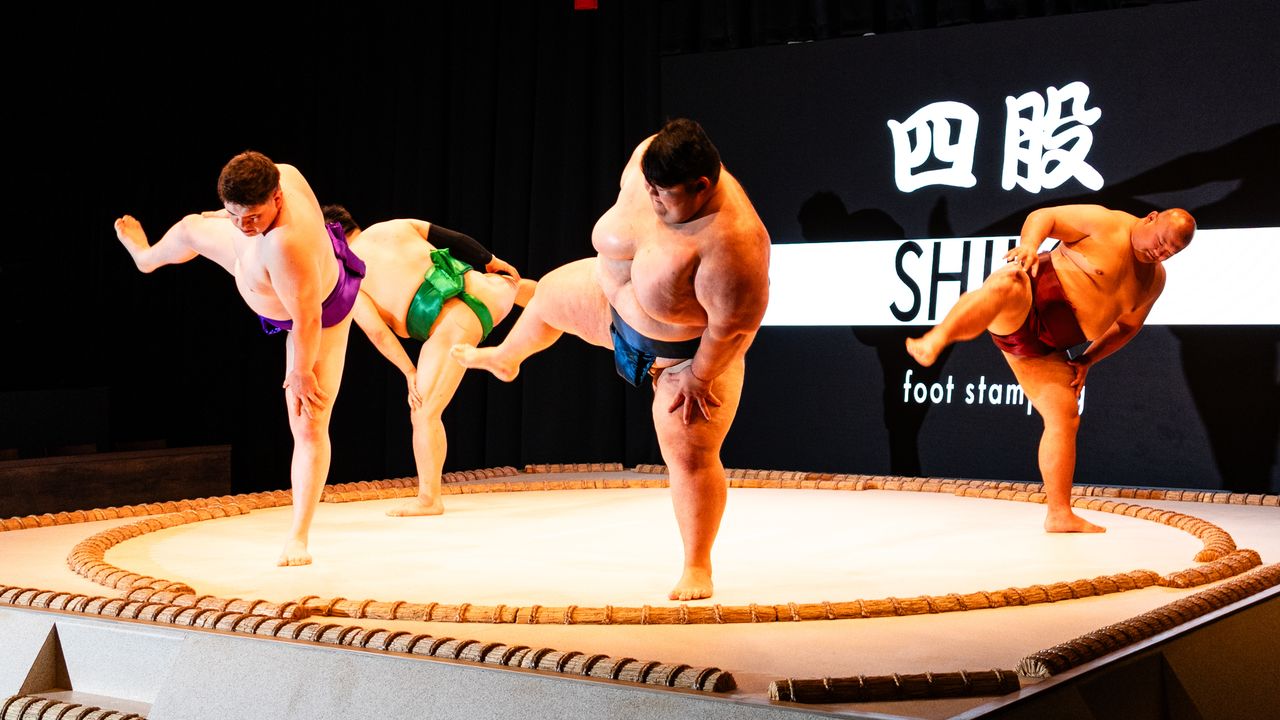
Sumō rules and rituals are explained in English. (© Nippon.com)
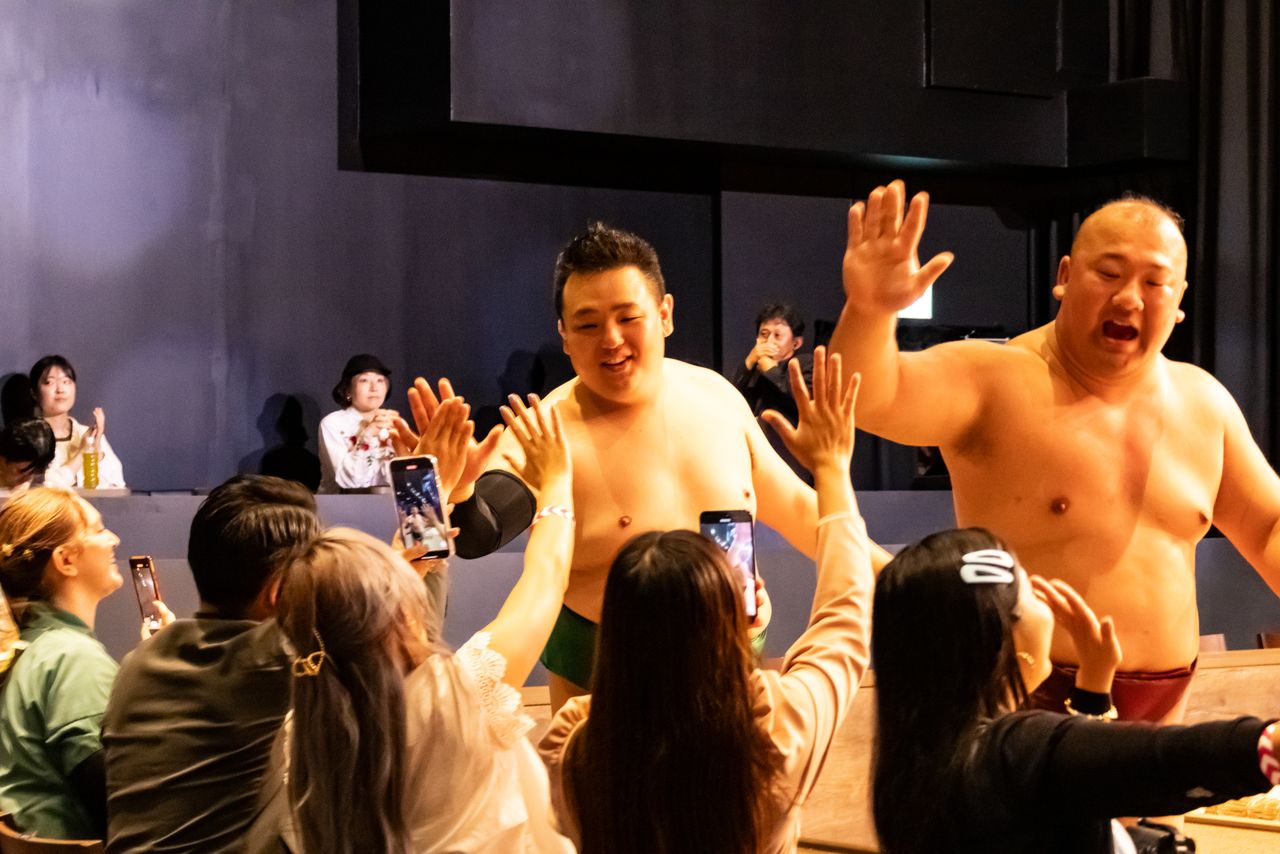
Spectators are allowed to give high-fives and pose for photos with wrestlers even during performances. There is also plenty of time afterwards for meet-and-greets. (© Nippon.com)
The performers are all former rikishi, professional sumō wrestlers, who put on a thrilling one-hour show. Members of the audience are invited to get into the ring too, providing the thrill of a hands-on experience.
Prior to the official opening, Katsura Fukuryū, a Canadian-born rakugo comic storyteller, entertained as the warm-up act. In a mixture of English and Japanese finely calibrated to draw out laughs, he explained the basic points of sumō for beginners.
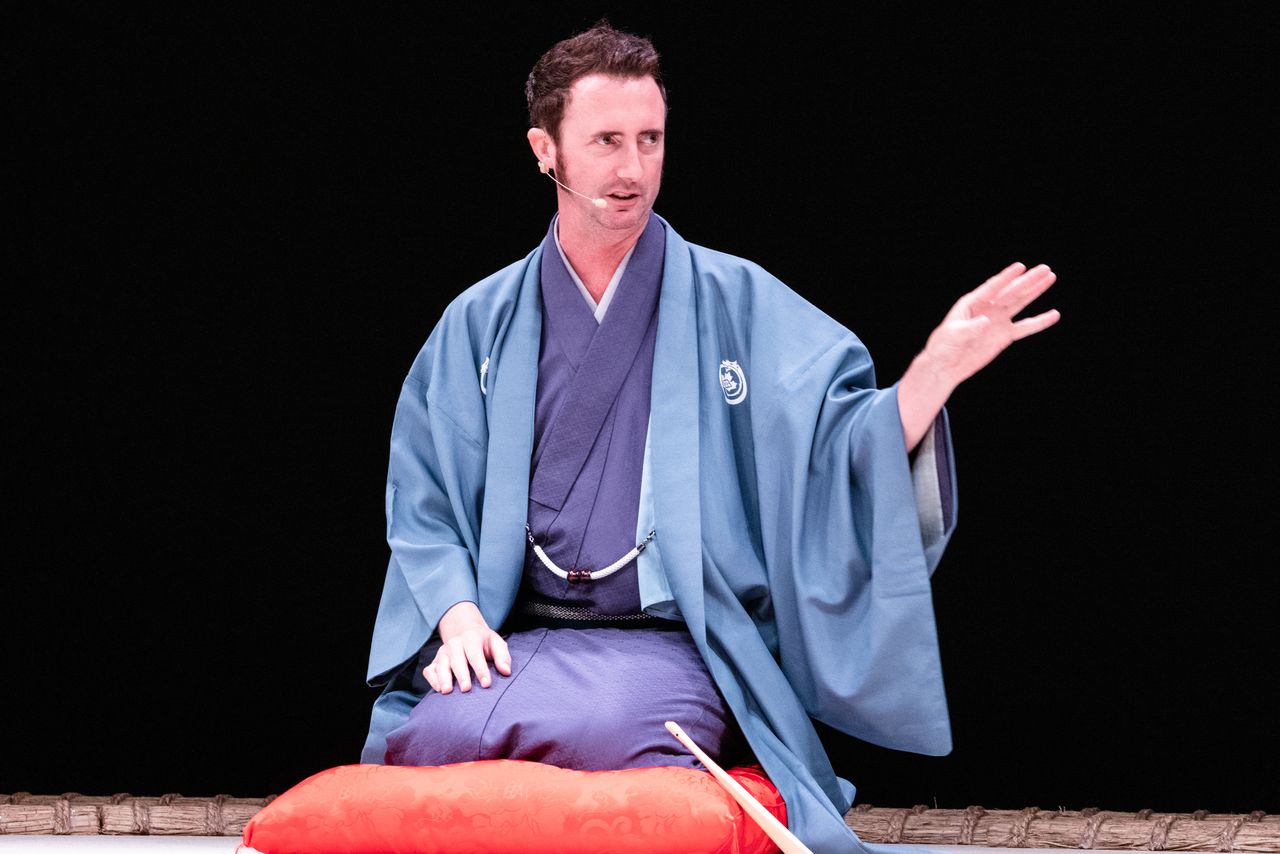
Rakugo storyteller Katsura Fukuryū starts the show with a humorous performance. (© Nippon.com)
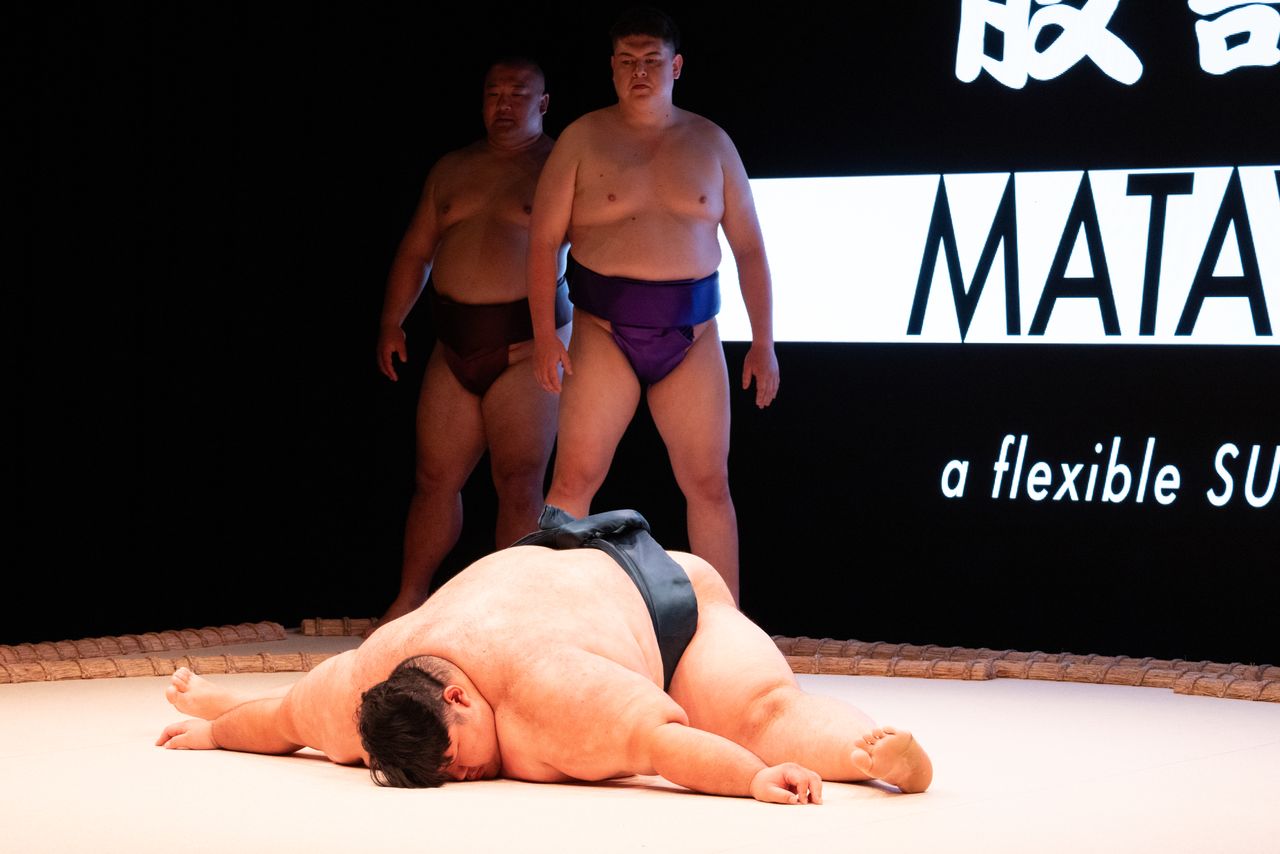
The ultimate splits, with legs splayed 180° and flat on the floor. (© Nippon.com)
Actions like shiko, the deep knee bends and stomping in the ring that precede a bout, and uwatenage overarm throw and other winning moves, are demonstrated convincingly by the performers, former professional sumō wrestlers with skills honed through years of practice. On a more lighthearted note, shokkiri, a comic sumō performance, is used to act out kinjite, or forbidden moves, enhanced by dramatic narration and lighting effects.
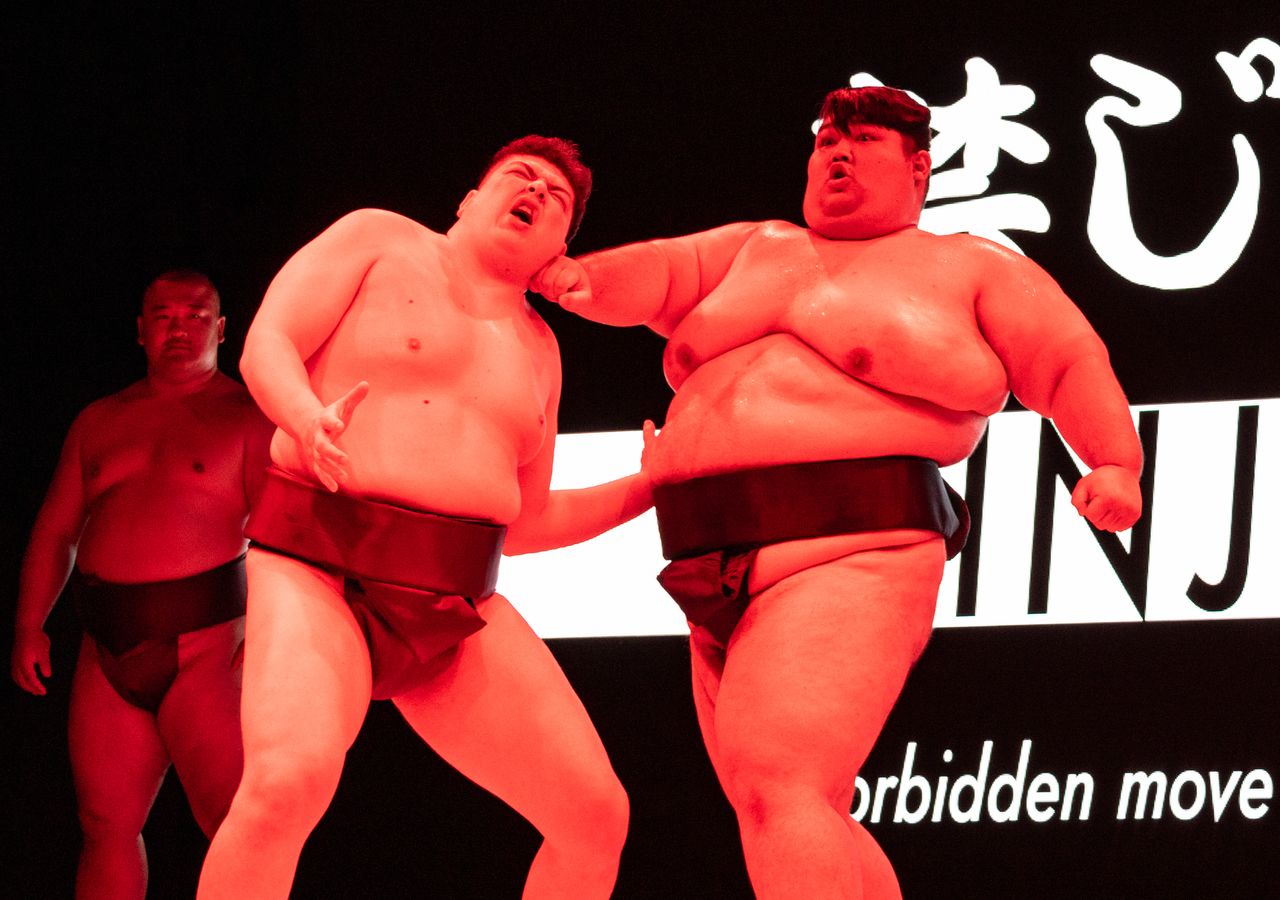
A humorous demonstration of “no punching” and other moves that are against the rules. (© Nippon.com)
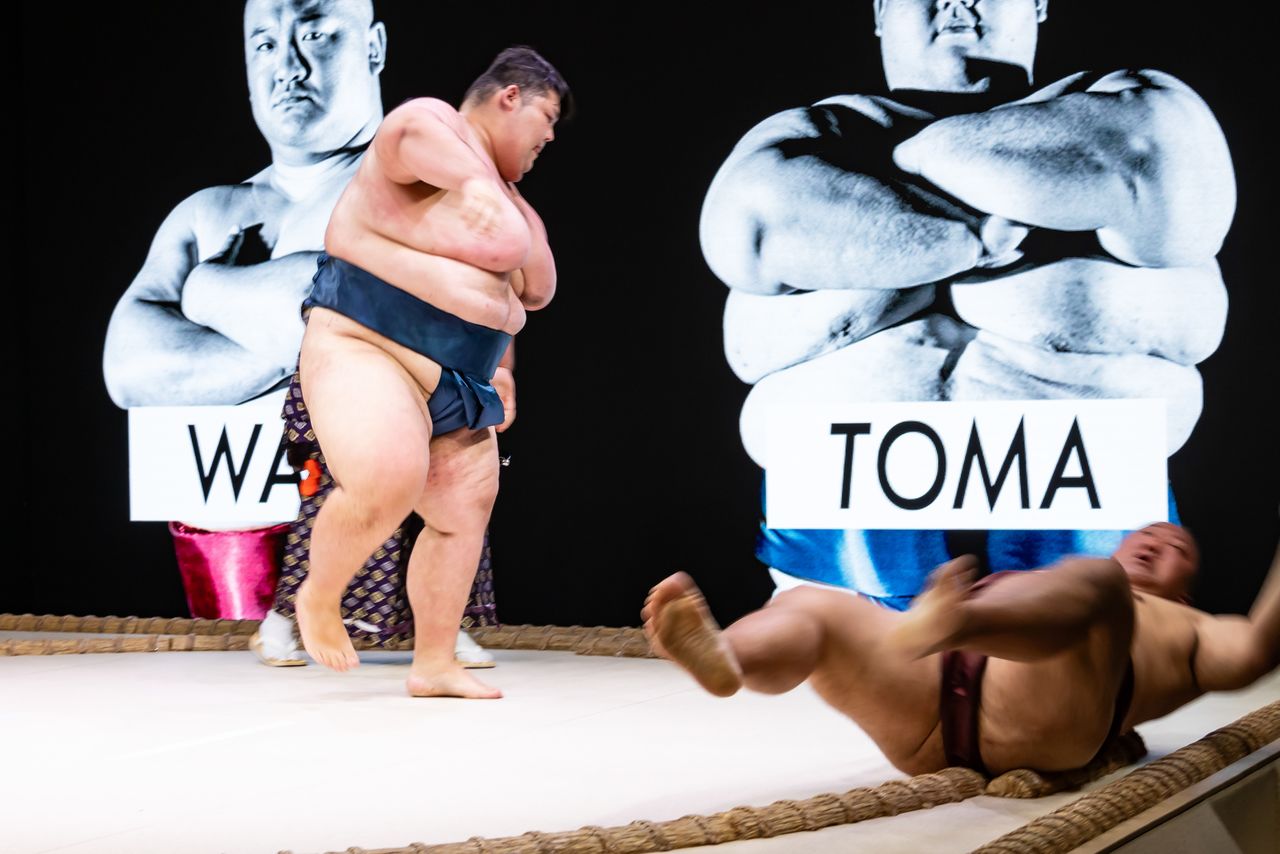
The thud of massive rikishi colliding at face-off is an exciting element of the performance. (© Nippon.com)
With the audience thus warmed up, a gyōji (referee) appears in the ring and the matches start. The fighters are focused on doing their best, and the tachiai face-off is performed exactly as it is during tournaments. Matches can take an exciting turn, as when a wrestler forced to the edge of the ring pivots back and succeeds in downing his opponent for a win.
For the finale, an audience member is invited into the ring and chooses a rikishi to take on. The colossus can lift would-be opponents off their feet in the blink of an eye, so amateur challengers have no chance of moving him even a fraction, but being downed and rolled around in the ring is no doubt a memorable experience.
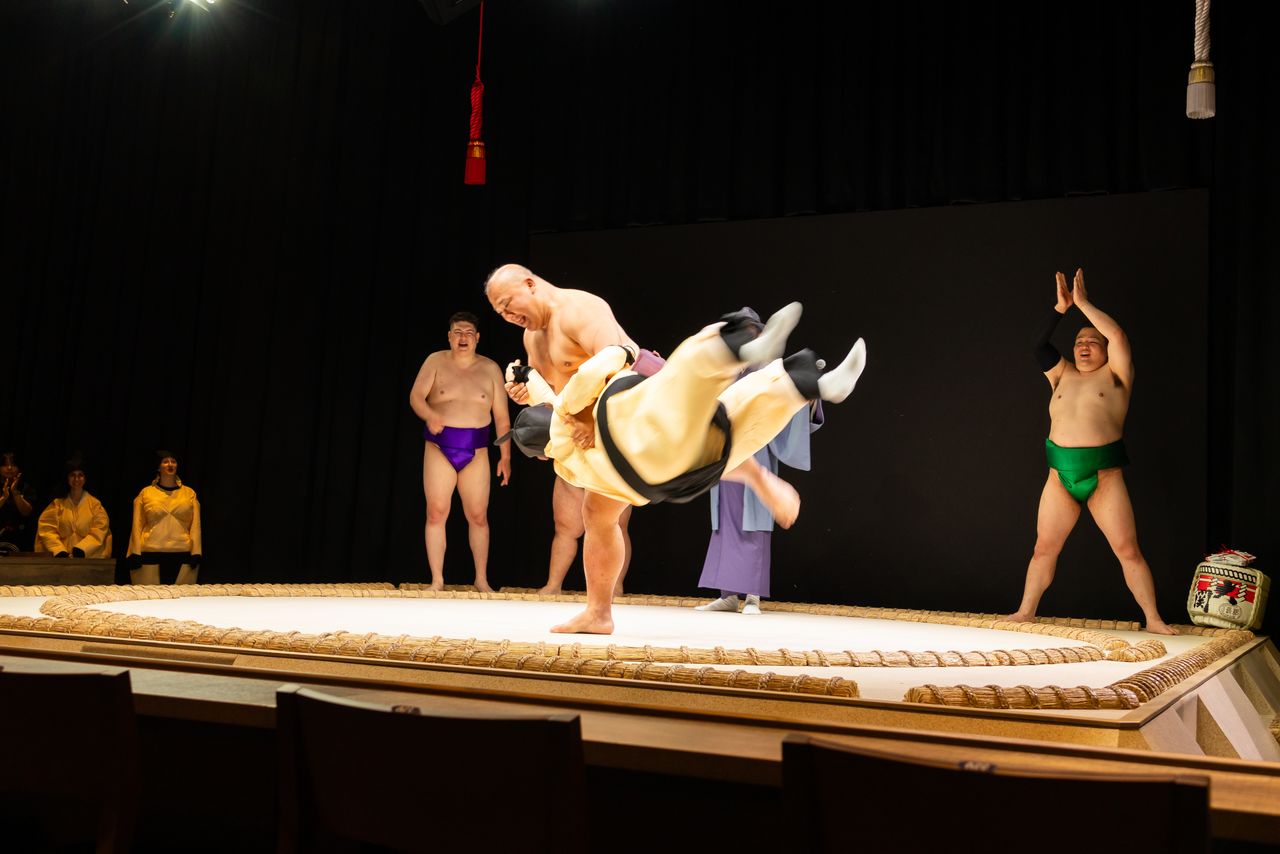
Women can also get thrown around in the ring; the padded sumō suit gives some protection. (© Nippon.com)
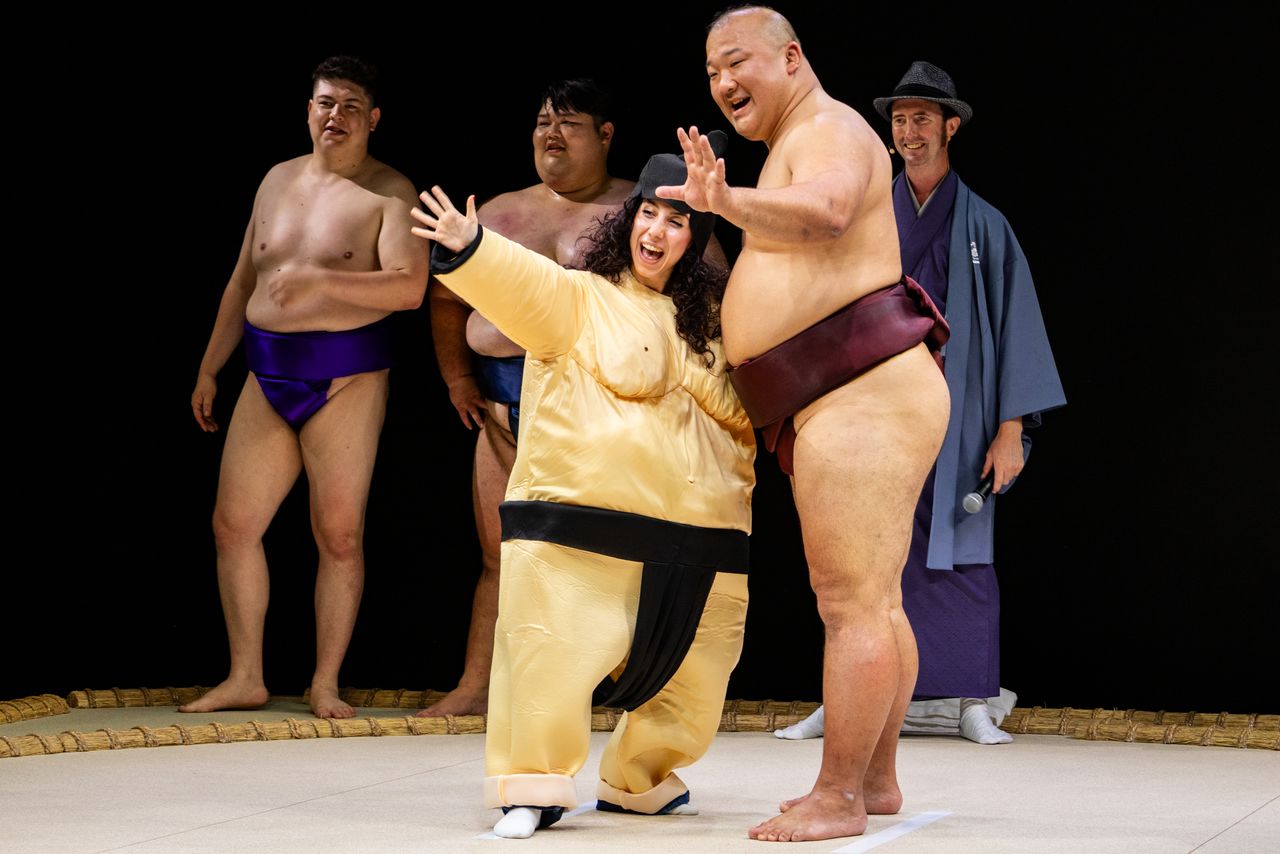
An audience member posing in the ring after the match. (© Nippon.com)
Introducing Sumō to the World
Former rikishi Tashiro Yoshinori was involved in suggesting and planning the Hirakuza performance. After retiring from the ring, Tashiro started a second career appearing in Hollywood films as a sumō actor. Ten years ago, he began organizing sumō shows for foreign visitors.
In the course of giving performances, he realized that non-Japanese were very curious about sumō. They wanted to know why rikishi perform shiko, the ceremonial stamping inside the ring, and why they sprinkle salt before a bout. They were very surprised to learn that these actions are purification rituals originating in ancient religious rites.
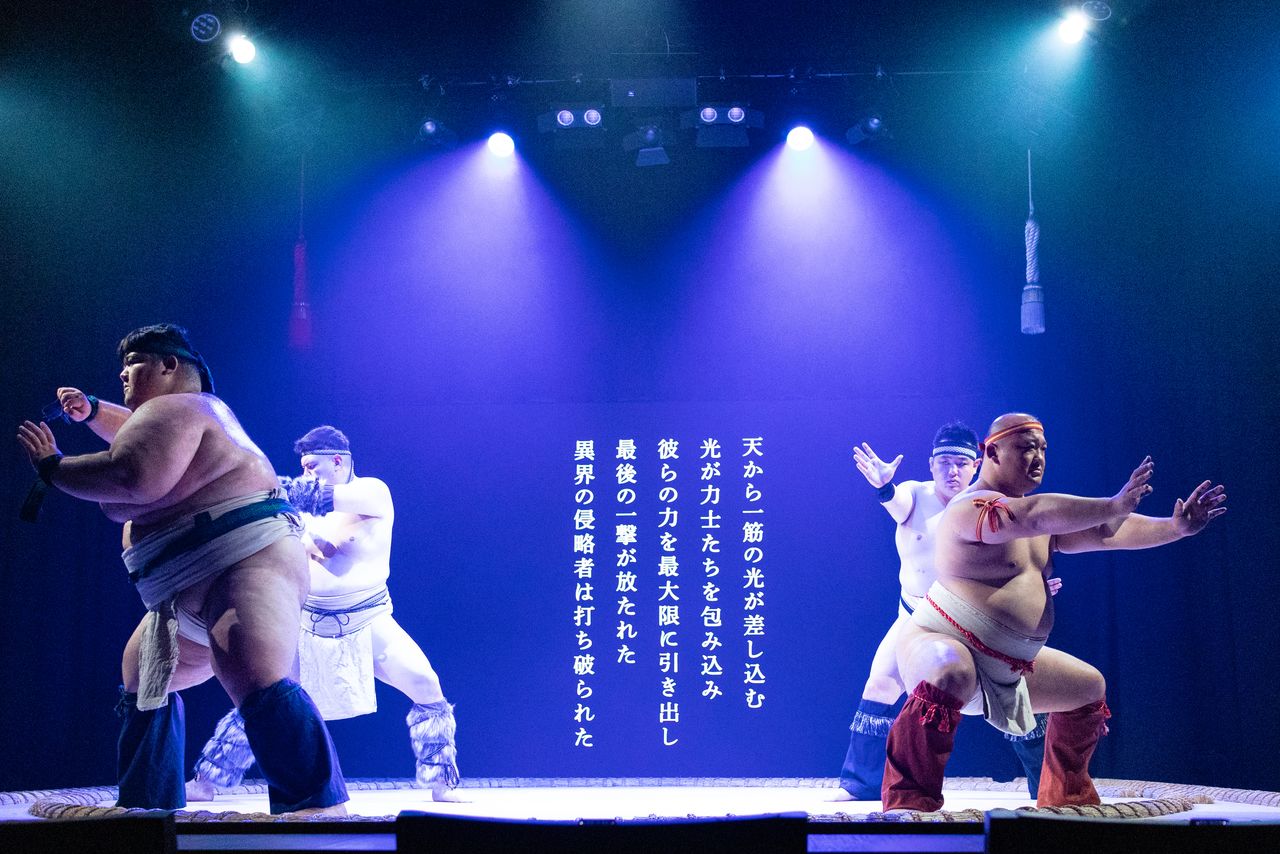
The awe-inspiring rikishi in the “Sumō Chronicles” sound and light performance. (© Nippon.com)
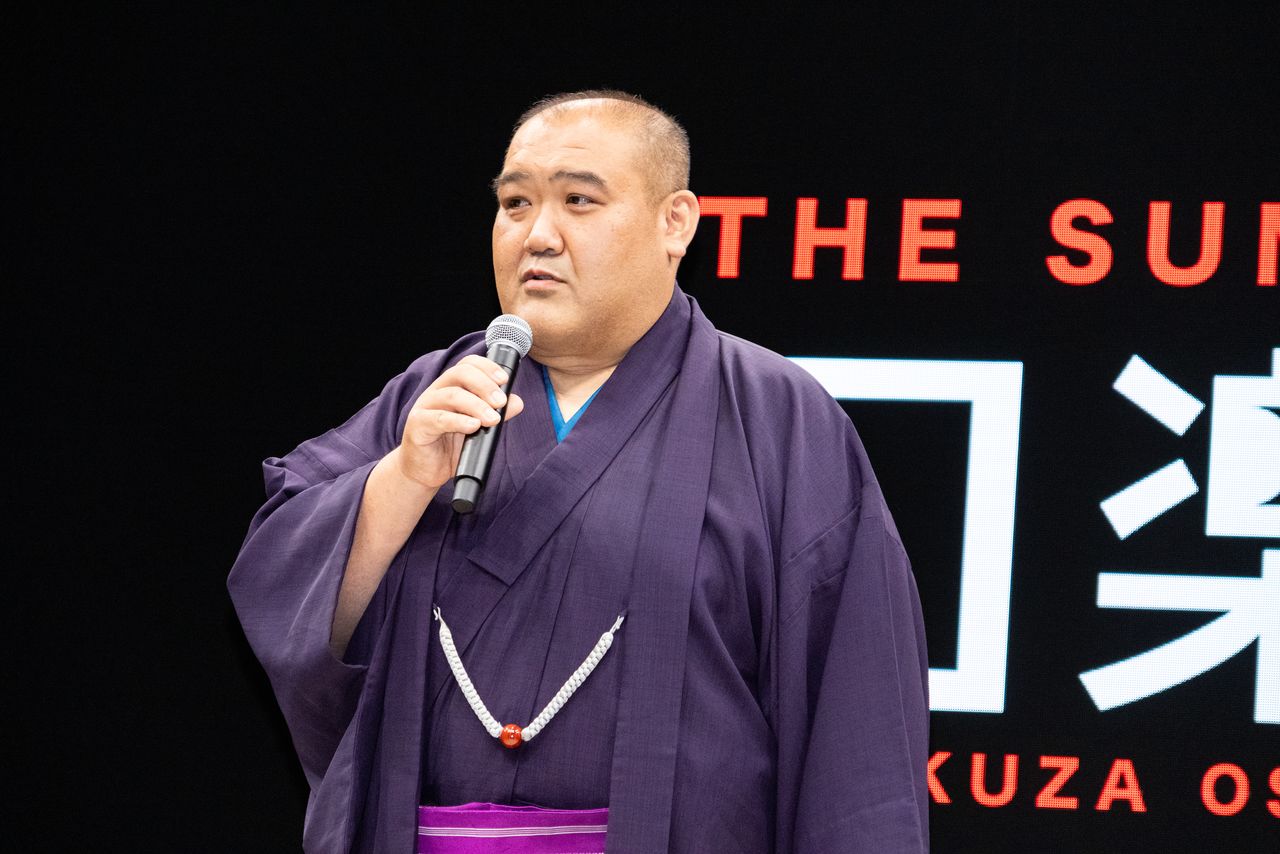
Tashiro Yoshinori, who has appeared in films like John Wick: Chapter 4. (© Nippon.com)
Sumō, Japan’s national sport, is known for the rules and traditions that set it apart from other sports. For example, rikishi must dress their hair in a topknot and wear kimono, and women are not allowed to tread on the dohyō. To help spectators understand that sumō is deeply rooted in Japanese culture and not simply a wrestling match between overweight men, Tashiro suggested adding commentary providing basic facts and covering the history of sumō and its origins in legend.
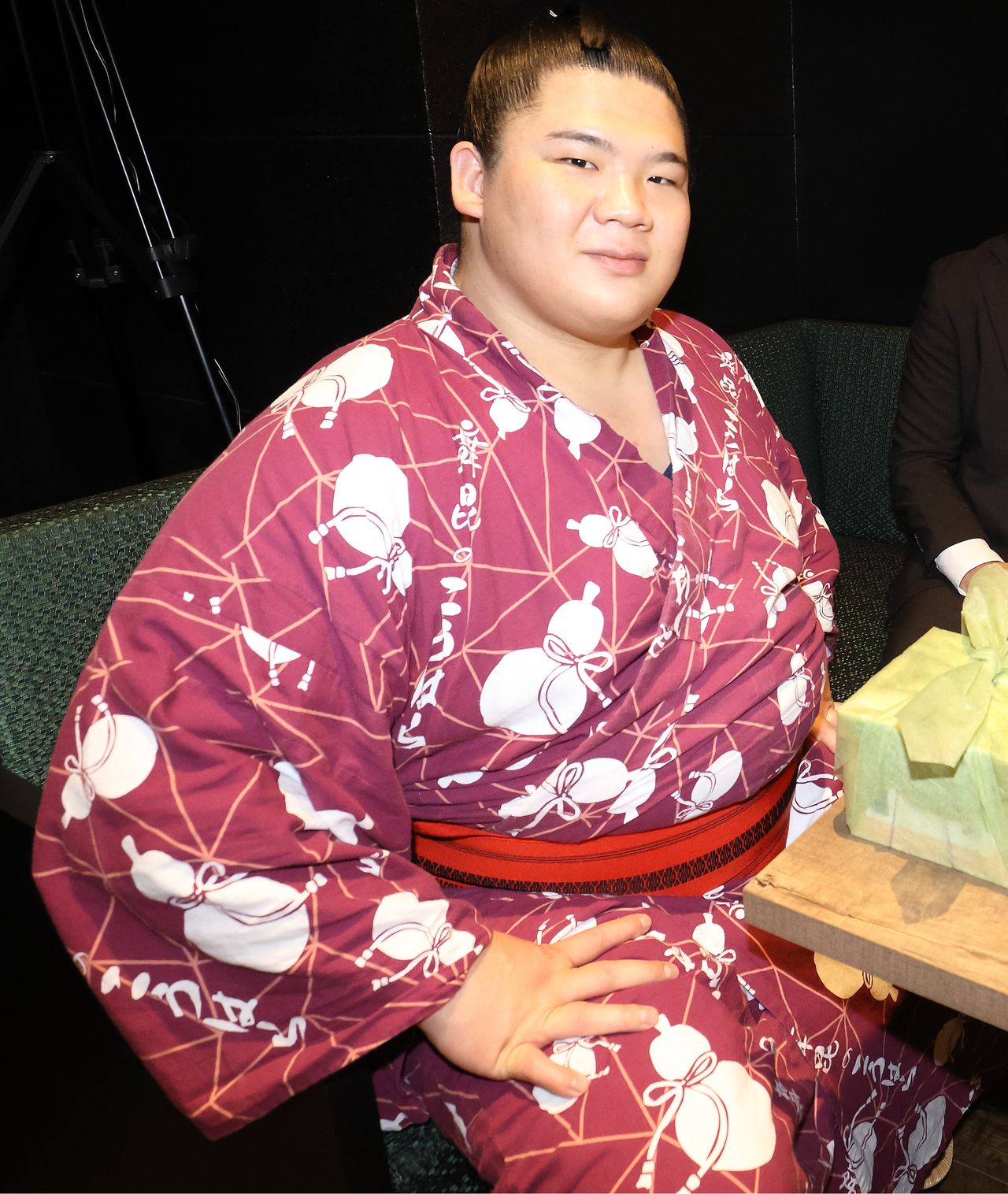
Popular top-ranking rikishi Ura took in a performance at Hirakuza after the Osaka tournament. He is reportedly happy that sumō is gaining popularity among foreign audiences. (Courtesy Hirakuza)
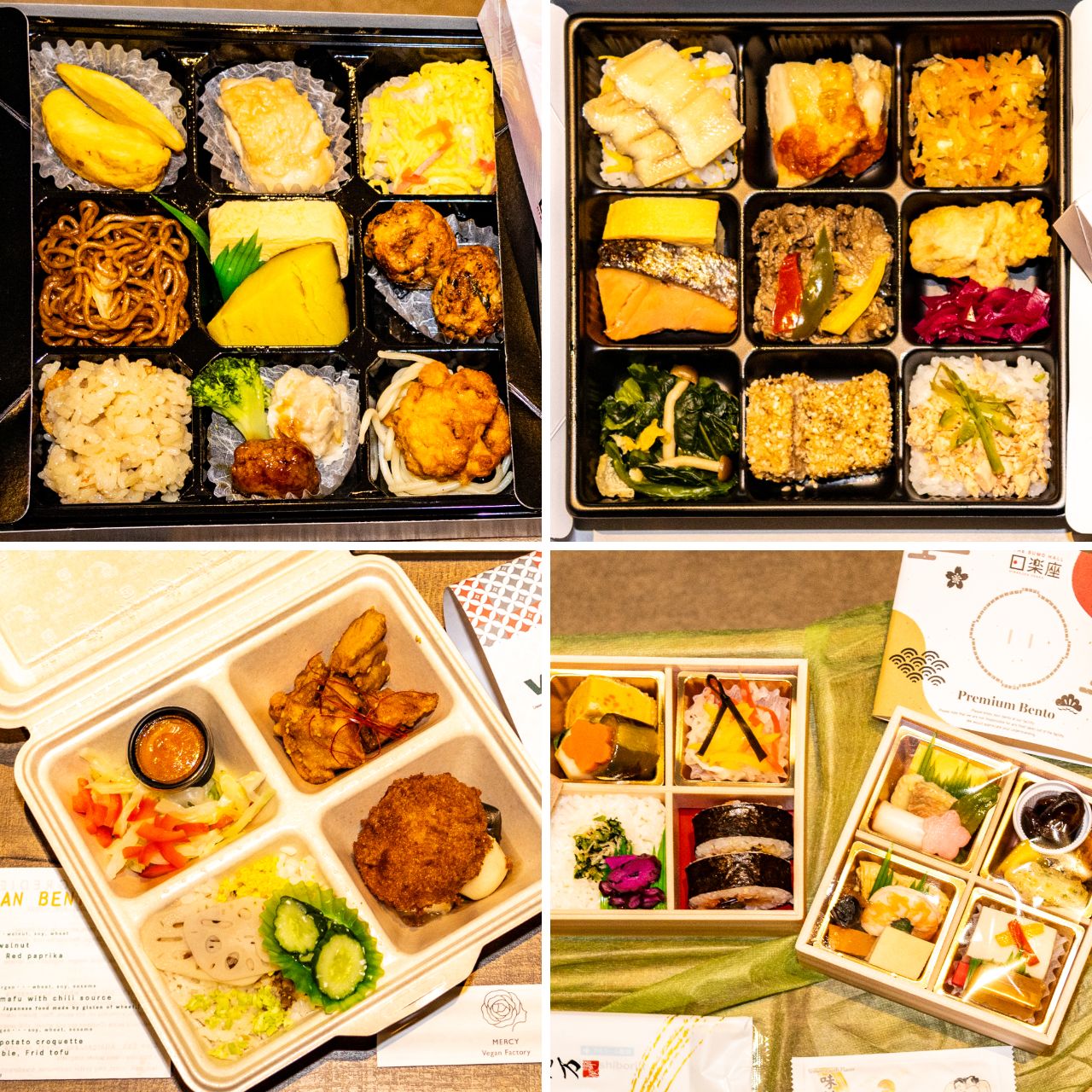
Boxed meals available at Hirakuza from top left: Hirakuza (makunouchi), halal, premium, and vegan. (© Nippon.com)
Performances start in the evening, meeting demand among foreign visitors for activities at this time. Admission includes a bentō boxed meal and one drink, including alcoholic beverages, replicating the official tournament experience and giving visitors a literal taste of Japanese culture. A variety of bentō are available, including the standard Hirakuza makunouchi featuring Osaka specialty takoyaki octopus balls. For an additional fee, there are options such as a premium two-tiered bentō prepared by famed Japanese cuisine restaurant Nadaman, and halal and vegan bentō.
Hirakuza is off to a strong start in its aim to share the thrills and culture of sumō with visitors from abroad.
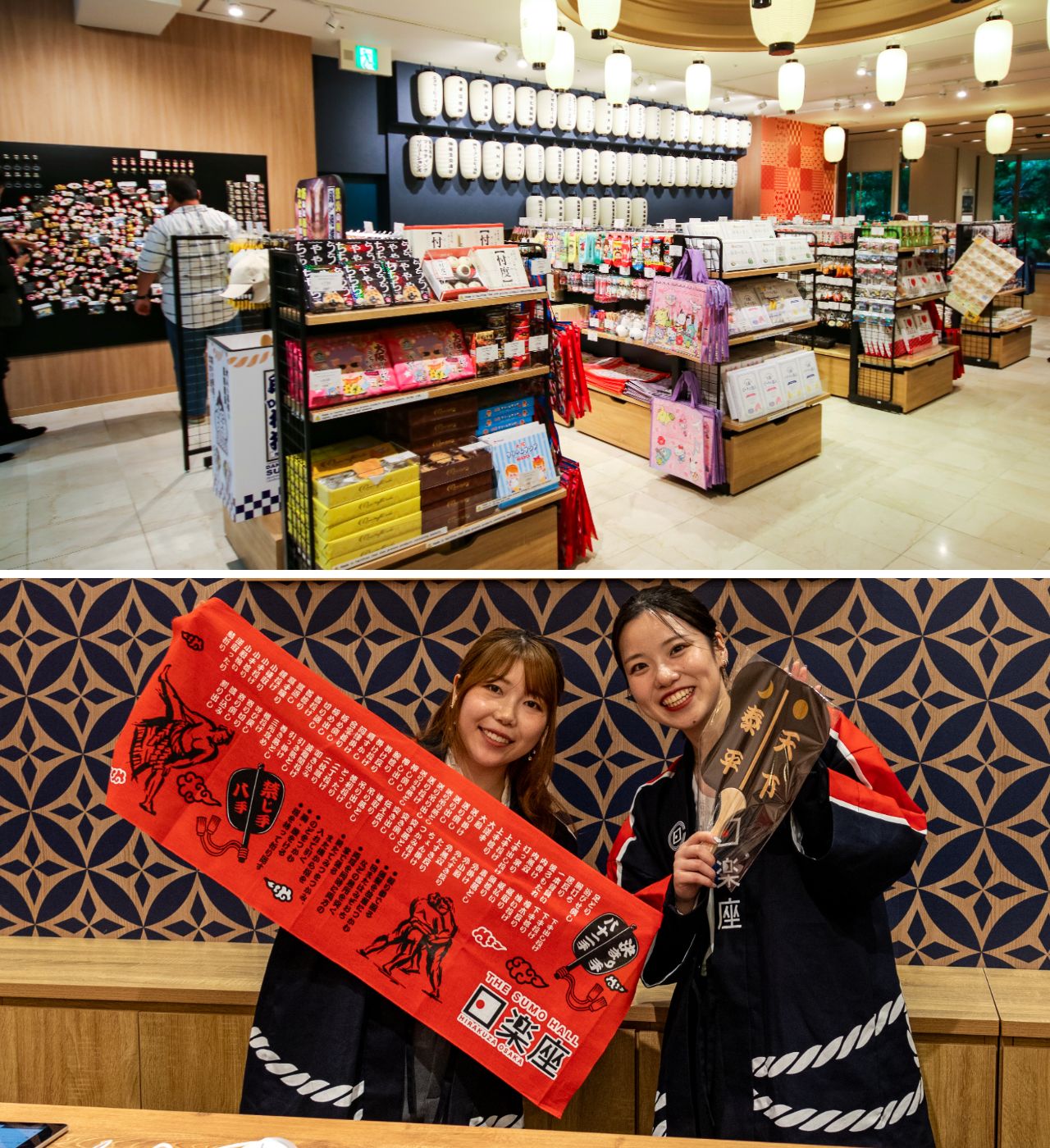
The gift shop is open to the public from 11 am. Tenugui hand towels showing various winning moves are a popular item. (© Nippon.com)

The venue, inside a shopping mall in the Minami entertainment district, is easily accessible by public transportation. (© Nippon.com)
Sumō Hall Hirakuza Osaka
- Address: Nanba Parks 8F, 2-10-70 Nanba-naka, Naniwa-ku, Osaka
- Opening hours: When there is one performance in a day, doors open at 6:00 pm for a 7:00 pm start. When there are two performances, doors open at 5:00 pm for the first start at 6:00 pm, and at 8:00 pm for the second start at 9:00. The shop is open from 11:00 am to 11:00 pm.
- Closed: Every Tuesday, as well as December 31 and January 1
- Standard admission prices: S seat ¥16,000, A seat ¥12,500, B seat ¥9,500 (including bentō and one drink)
- Access: 3 minutes’ walk from Nanba Station on the Nankai Railway and Osaka Metro, and 5 minutes’ walk from Osaka-Nanba Station on the Hanshin and Kintetsu Railways.
For more information and reservations, please visit:
https://hirakuza.net/sumohall/
(Originally published in Japanese. Banner photo © Nippon.com.)